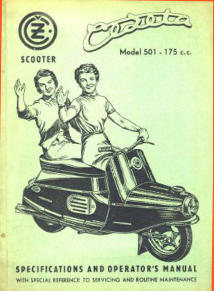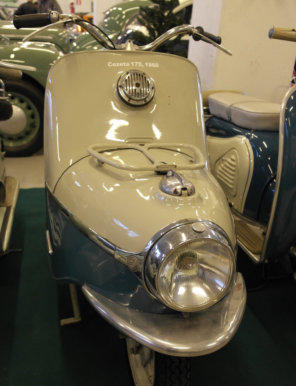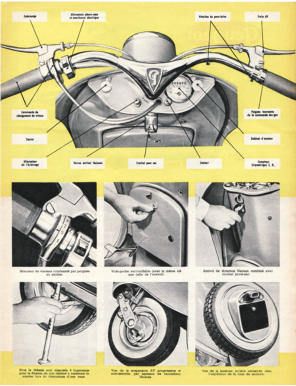
















A 3-wheeled Ricksaw was also available

Cezeta 175 - 1960
The Čezeta was originally a motor scooter manufactured
from 1957 to 1964 in what was then Czechoslovakia, (now
the Czech Republic), by the Česká Zbrojovka Strakonice
(ČZ) company, which manufactured motorcycles from
1935 to 1997. Production resumed in 2013 with the
introduction of a new hand-built electric version Type
506.
Types 501, 502 and 505
The original design of the Čezeta is unique amongst scooters. It is unusually long for a two-wheeled vehicle at 2 metres and has a distinctive torpedo-shaped body with a long seat
two-wheeled vehicle at 2 metres and has a distinctive torpedo-shaped body with a long seat that lifted to reveal a substantial luggage compartment, using space that in most scooters is
that lifted to reveal a substantial luggage compartment, using space that in most scooters is occupied by the fuel tank. The front mudguard is fixed to the body and fully streamlined into
occupied by the fuel tank. The front mudguard is fixed to the body and fully streamlined into the leg shields. The fuel tank is positioned above the front wheel, with the headlight fitted
the leg shields. The fuel tank is positioned above the front wheel, with the headlight fitted into a recess and a luggage rack on the flat top surface. It was a common joke amongst
into a recess and a luggage rack on the flat top surface. It was a common joke amongst Čezeta riders that the exposed front tank with built-in headlight formed an explosive
Čezeta riders that the exposed front tank with built-in headlight formed an explosive warhead and detonator for the torpedo, though in practice the Čezetas proved no more likely
to catch fire than any other motor scooter, even in serious collisions.
The scooter was driven by the 175cc ČZ two-stroke single-cylinder motorcycle engine, giving
warhead and detonator for the torpedo, though in practice the Čezetas proved no more likely
to catch fire than any other motor scooter, even in serious collisions.
The scooter was driven by the 175cc ČZ two-stroke single-cylinder motorcycle engine, giving a top speed of 55 mph and economy of 3.2 litres/100km. The engine was modified for the
a top speed of 55 mph and economy of 3.2 litres/100km. The engine was modified for the enclosed scooter by having a drive pulley on the crankshaft driving a fan by means of a Vee
enclosed scooter by having a drive pulley on the crankshaft driving a fan by means of a Vee belt. There were four foot-operated gears.
The original petrol versions were given type numbers that indicate their features. The first
belt. There were four foot-operated gears.
The original petrol versions were given type numbers that indicate their features. The first production started with Type 501, then with advancements like a starter motor a type 502
production started with Type 501, then with advancements like a starter motor a type 502 was later released. The 501 model, built from 1957 to 1959, had the rear wheel supported on
was later released. The 501 model, built from 1957 to 1959, had the rear wheel supported on one side only and suspended by a rubber block. The later 502 model had a full fork with
one side only and suspended by a rubber block. The later 502 model had a full fork with motorcycle shock absorbers. These types contain sub-types to further indicate their features,
for example type 502/00 is a 12V model with electric starter, and a type 502/01 is a 6V
motorcycle shock absorbers. These types contain sub-types to further indicate their features,
for example type 502/00 is a 12V model with electric starter, and a type 502/01 is a 6V model with foot-crank starting.
model with foot-crank starting. A three-wheeled utility version, the type 505 (or 'rickshaw'), was built starting in 1960. This
A three-wheeled utility version, the type 505 (or 'rickshaw'), was built starting in 1960. This vehicle used mechanical components and front bodywork from the 502.
A popular sidecar was also produced, though in limited numbers - approximately 900 in total
vehicle used mechanical components and front bodywork from the 502.
A popular sidecar was also produced, though in limited numbers - approximately 900 in total - by Drupol in Stiřín near Prague. This was sold as the 'Druzeta', the name coming as a
- by Drupol in Stiřín near Prague. This was sold as the 'Druzeta', the name coming as a combination of the two companies names.
combination of the two companies names.
Type 506
In 2012, a new prototype Čezeta type 506 was made. This new scooter uses electric power in a rear hub motor and is powered by a large bank of lithium-ion cells to make a high-
a rear hub motor and is powered by a large bank of lithium-ion cells to make a high- performance touring scooter. A new Czech company was registered for the project (čezeta
performance touring scooter. A new Czech company was registered for the project (čezeta motors s.r.o.), and the čezeta trademarks are licensed to this company. Production of the
motors s.r.o.), and the čezeta trademarks are licensed to this company. Production of the new type 506 started in June 2013, nearly exactly 50 years after production of the petrol
new type 506 started in June 2013, nearly exactly 50 years after production of the petrol versions had stopped.
versions had stopped.
N-Zeta
In New Zealand, during the 1960s a local company, JNZ Manufacturing Ltd assembled the 'Čezeta' under the name 'N-Zeta'. It was fitted with a larger, 200cc two stroke motor. New
'Čezeta' under the name 'N-Zeta'. It was fitted with a larger, 200cc two stroke motor. New Zealand production was from 1958 or 1959 to perhaps 1964. The point of New Zealand
Zealand production was from 1958 or 1959 to perhaps 1964. The point of New Zealand production was that high import duties were placed on imported motor vehicles. New
production was that high import duties were placed on imported motor vehicles. New Zealand assembly reduced the imported cost and hence the duty. Further, New Zealand
Zealand assembly reduced the imported cost and hence the duty. Further, New Zealand manufacture of components further reduced the duty. The JNZ Man Ltd apparently achieved
manufacture of components further reduced the duty. The JNZ Man Ltd apparently achieved 50% New Zealand manufacture by value, with tyres, seat, trim, lights, controls etc. The 501
50% New Zealand manufacture by value, with tyres, seat, trim, lights, controls etc. The 501 model is identified visually by a center skirt horn and dual exhausts. It produced 8 bhp and
model is identified visually by a center skirt horn and dual exhausts. It produced 8 bhp and could go 50 mph. The 502 model is identified visually by no center skirt horn and a single
could go 50 mph. The 502 model is identified visually by no center skirt horn and a single exhaust. Output was 9.5 bhp, and top speed was 59mph. The 502 was available with electric
exhaust. Output was 9.5 bhp, and top speed was 59mph. The 502 was available with electric start. Most mechanical parts were common with Jawa/CZs motorcycle range, except for the
start. Most mechanical parts were common with Jawa/CZs motorcycle range, except for the frame and wheels.
frame and wheels.

1960
 Engine
174 cc
2-stroke
Engine
174 cc
2-stroke




Photos mainly by Matti Kreivilä. Historical facts and technical details of the vehicles provided by Wikipedia. Movies YouTube.













